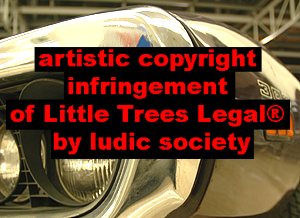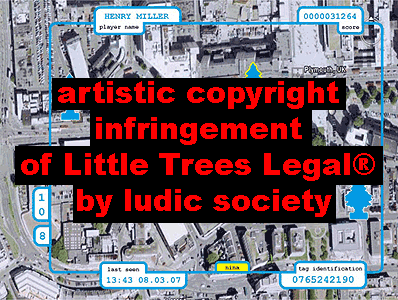He causes all, the small and the great, the rich and the poor, and the free and the slave,
to be given marks on their right hands, or on their foreheads;
and that no one would be able to buy or to sell,
unless he has that mark, the name of the beast or the number of his name.
The Bible. Book of Revelations [13:16-17]

"A handful of companies in Europe produce Little Trees under license, using the names Magic Tree (UK, Ireland), Wunder-Baum (Sweden, Germany, Norway, Finland), and Arbre Magique (France, Italy, Spain, Portugal). In Sweden the Wunder-Baum brand is sometimes associated with the raggare culture." source wikipedia
game mechanics
We are designing the hardware to use three RFID based components. First of all we will have a reader built from separate components to our own design it uses the ID2 module and antenna from Mannings RFID and shall be designed to look like a wunderbaum tree. Secondly we will have a RFID finder again custom built in the shape of a wunderbaum tree, which finds low frequency tags compatible with our reader. Thirdly we hope to build an RFID zapper, which uses a mini EMP field to destroy an RFID tag. With these three components different game play is achievable with a player having the ability to place, find and remove tags.
The software will be built using Google Maps, an interface that most internet users are familiar with, and then overlay Macromedia Flash to provided our additional information, animation etc. Points on the map are plotted dynamically from a MySQL database using PHP and JSON, and this is also fed into Flash via Javascript to plot the corresponding game play information about the wunderbaum trees.
 Wunderbaum interface for player
Wunderbaum interface for player
To add a wunderbaum tree to the map a player must first have the RFID implant read to allow the system to indentify them. If they have not previously been introduced to the map then they will be prompted to add their details; name and email address. The player will then either be able to add a new wunderbaum tree or edit an existing wunderbaum tree already present on the map. Either option will allow the player to upload content in the form of a name, description, image, video, sound etc. When the wunderbaum tree is added the borgesian psycho active play map will automatically refresh to show the new tree and player squiggle.
Game interface for spectator.
When a spectator logs onto the borgesian psycho active play map they will initially have a visual all of the wunderbaum trees and squiggles (conduits or tracks between waypoints) for all players. The borgesian map will be centred on one randomly selected player, with the zoom level and boundary of the map being defined by their wunderbaum trees. If the player has concentrated their
 activity to a small geographic area then the zoom level will be high and the overall visible area of the map small. If the player selected has travelled further a field to tag locations and objects, the zoom level will be less showing a greater geographical area. As the starting view for the player is random, therefore each time a spectator views the map they should see a different section of the play area. The spectator will have access to a button that allows them to traverse through the squiggles, turning them off, cycling through all active players squiggles, and then returning them to all squiggles turned on. As the spectator cycles the squiggles the HUD will update to reflect the information of that particular player, showing name, score, ID number and last time seen. When a spectator clicks on a tree a overlay window will show the content associated with that tree. Including GEOlocation of the tag, its status, content added by each player which includes images, title etc, the timestamp of when the content was added and also the score of the player who added the content.
activity to a small geographic area then the zoom level will be high and the overall visible area of the map small. If the player selected has travelled further a field to tag locations and objects, the zoom level will be less showing a greater geographical area. As the starting view for the player is random, therefore each time a spectator views the map they should see a different section of the play area. The spectator will have access to a button that allows them to traverse through the squiggles, turning them off, cycling through all active players squiggles, and then returning them to all squiggles turned on. As the spectator cycles the squiggles the HUD will update to reflect the information of that particular player, showing name, score, ID number and last time seen. When a spectator clicks on a tree a overlay window will show the content associated with that tree. Including GEOlocation of the tag, its status, content added by each player which includes images, title etc, the timestamp of when the content was added and also the score of the player who added the content.
Please also see the blog of DJ
Shingleton

 Wunderbaum interface for player
Wunderbaum interface for player
 activity to a small geographic area then the zoom level will be high and the overall visible area of the map small. If the player selected has travelled further a field to tag locations and objects, the zoom level will be less showing a greater geographical area. As the starting view for the player is random, therefore each time a spectator views the map they should see a different section of the play area. The spectator will have access to a button that allows them to traverse through the squiggles, turning them off, cycling through all active players squiggles, and then returning them to all squiggles turned on. As the spectator cycles the squiggles the HUD will update to reflect the information of that particular player, showing name, score, ID number and last time seen. When a spectator clicks on a tree a overlay window will show the content associated with that tree. Including GEOlocation of the tag, its status, content added by each player which includes images, title etc, the timestamp of when the content was added and also the score of the player who added the content.
activity to a small geographic area then the zoom level will be high and the overall visible area of the map small. If the player selected has travelled further a field to tag locations and objects, the zoom level will be less showing a greater geographical area. As the starting view for the player is random, therefore each time a spectator views the map they should see a different section of the play area. The spectator will have access to a button that allows them to traverse through the squiggles, turning them off, cycling through all active players squiggles, and then returning them to all squiggles turned on. As the spectator cycles the squiggles the HUD will update to reflect the information of that particular player, showing name, score, ID number and last time seen. When a spectator clicks on a tree a overlay window will show the content associated with that tree. Including GEOlocation of the tag, its status, content added by each player which includes images, title etc, the timestamp of when the content was added and also the score of the player who added the content.